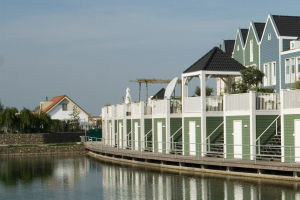When we talk about wetlands, most people probably think of the ecosystems here, their prosperity, and abundance. Few people think of building houses on wetlands. In fact, in some areas, houses on wetlands are not uncommon.
A house on a wetland is a special type of residential building designed to adapt to the wetland environment. These houses are often built on lakes, ponds, or swamps and are usually made of lightweight materials such as bamboo, wood, or lepidopterous wood.
When building these houses, some important factors need to be taken into account, including the stability of the building, seismic resistance, water resistance, and light. This style of architecture maximizes the pecking order of the ecosystems in these areas and allows people to live comfortably in these environments.
So, what are the advantages of a house on a wetland? First, these houses are relatively inexpensive to build, and building materials are relatively easy to obtain. Second, houses on wetlands not only meet the housing needs but also maintain the natural environment of the wetlands.
Most importantly, houses on wetlands are also well-adapted to natural conditions, such as high rainfall and wet conditions. These advantages make a house on a wetland a unique type of eco-housing architecture.
Although houses on wetlands have many advantages, they still have some disadvantages. First, these houses are highly specialized, and the craft of building them requires a certain level of skill. Second, houses on wetlands face a range of environmental challenges, such as changing water levels, flooding, and storms.
While these challenges may be overcome with the right technology, they also introduce a certain level of uncertainty into the house. In addition, due to the high level of specialization, a house on a wetland is likely unable to take on the task of large-scale construction, making it still unpopular.
The difficulty of building a house on a wetland is not only technical but also requires consideration of environmental protection and ecological balance.
The construction of these houses needs to follow certain environmental norms and construction standards to protect and maintain the integrity and stability of the wetland ecosystem to make full use of the wetland resources while not causing any damage to the natural environment.
Therefore, in building houses on wetlands, architects and designers need to work closely together, taking into account the balance between the sustainability of the building and the stability of the wetland ecosystem.
In the future, houses on wetlands will continue to evolve. Some scientists believe that this style of architecture will reduce disturbance to the land while maintaining the ecological balance of the wetlands. In addition, as urbanization continues, more and more people tend to live in urban, high-rise buildings, and a house on a wetland may be able to accommodate certain people's needs. In the future, this architectural style may replace traditional buildings to some extent.
A house on a wetland is a green, ecological, and sustainable architectural style that has a wide range of applications and markets in all future architectural fields. As people pay more and more attention to environmental protection, sustainability, and ecological balance, a house on a wetland will continue to develop its characteristics and become the crystallization of human wisdom and creativity.
As an emerging eco-architecture style, in the future, a house on a wetland will lead to another change in the construction industry, creating a more wonderful and sustainable future.


